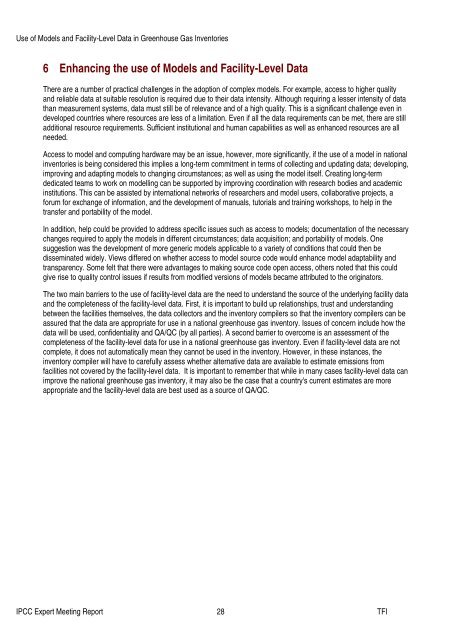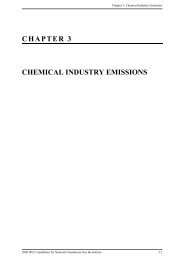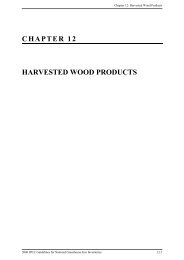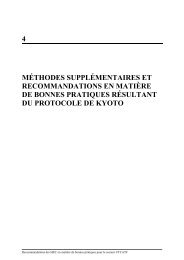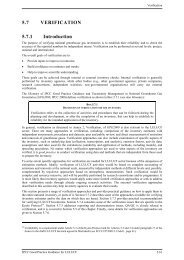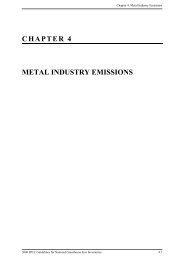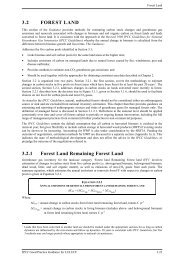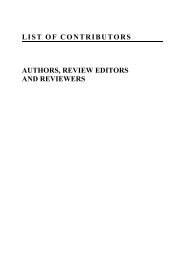Use of Models and Facility-Level Data in Greenhouse Gas Inventories
Use of Models and Facility-Level Data in Greenhouse Gas Inventories
Use of Models and Facility-Level Data in Greenhouse Gas Inventories
You also want an ePaper? Increase the reach of your titles
YUMPU automatically turns print PDFs into web optimized ePapers that Google loves.
<strong>Use</strong> <strong>of</strong> <strong>Models</strong> <strong>and</strong> <strong>Facility</strong>-<strong>Level</strong> <strong>Data</strong> <strong>in</strong> <strong>Greenhouse</strong> <strong>Gas</strong> <strong>Inventories</strong><br />
6 Enhanc<strong>in</strong>g the use <strong>of</strong> <strong>Models</strong> <strong>and</strong> <strong>Facility</strong>-<strong>Level</strong> <strong>Data</strong><br />
There are a number <strong>of</strong> practical challenges <strong>in</strong> the adoption <strong>of</strong> complex models. For example, access to higher quality<br />
<strong>and</strong> reliable data at suitable resolution is required due to their data <strong>in</strong>tensity. Although requir<strong>in</strong>g a lesser <strong>in</strong>tensity <strong>of</strong> data<br />
than measurement systems, data must still be <strong>of</strong> relevance <strong>and</strong> <strong>of</strong> a high quality. This is a significant challenge even <strong>in</strong><br />
developed countries where resources are less <strong>of</strong> a limitation. Even if all the data requirements can be met, there are still<br />
additional resource requirements. Sufficient <strong>in</strong>stitutional <strong>and</strong> human capabilities as well as enhanced resources are all<br />
needed.<br />
Access to model <strong>and</strong> comput<strong>in</strong>g hardware may be an issue, however, more significantly, if the use <strong>of</strong> a model <strong>in</strong> national<br />
<strong>in</strong>ventories is be<strong>in</strong>g considered this implies a long-term commitment <strong>in</strong> terms <strong>of</strong> collect<strong>in</strong>g <strong>and</strong> updat<strong>in</strong>g data; develop<strong>in</strong>g,<br />
improv<strong>in</strong>g <strong>and</strong> adapt<strong>in</strong>g models to chang<strong>in</strong>g circumstances; as well as us<strong>in</strong>g the model itself. Creat<strong>in</strong>g long-term<br />
dedicated teams to work on modell<strong>in</strong>g can be supported by improv<strong>in</strong>g coord<strong>in</strong>ation with research bodies <strong>and</strong> academic<br />
<strong>in</strong>stitutions. This can be assisted by <strong>in</strong>ternational networks <strong>of</strong> researchers <strong>and</strong> model users, collaborative projects, a<br />
forum for exchange <strong>of</strong> <strong>in</strong>formation, <strong>and</strong> the development <strong>of</strong> manuals, tutorials <strong>and</strong> tra<strong>in</strong><strong>in</strong>g workshops, to help <strong>in</strong> the<br />
transfer <strong>and</strong> portability <strong>of</strong> the model.<br />
In addition, help could be provided to address specific issues such as access to models; documentation <strong>of</strong> the necessary<br />
changes required to apply the models <strong>in</strong> different circumstances; data acquisition; <strong>and</strong> portability <strong>of</strong> models. One<br />
suggestion was the development <strong>of</strong> more generic models applicable to a variety <strong>of</strong> conditions that could then be<br />
dissem<strong>in</strong>ated widely. Views differed on whether access to model source code would enhance model adaptability <strong>and</strong><br />
transparency. Some felt that there were advantages to mak<strong>in</strong>g source code open access, others noted that this could<br />
give rise to quality control issues if results from modified versions <strong>of</strong> models became attributed to the orig<strong>in</strong>ators.<br />
The two ma<strong>in</strong> barriers to the use <strong>of</strong> facility-level data are the need to underst<strong>and</strong> the source <strong>of</strong> the underly<strong>in</strong>g facility data<br />
<strong>and</strong> the completeness <strong>of</strong> the facility-level data. First, it is important to build up relationships, trust <strong>and</strong> underst<strong>and</strong><strong>in</strong>g<br />
between the facilities themselves, the data collectors <strong>and</strong> the <strong>in</strong>ventory compilers so that the <strong>in</strong>ventory compilers can be<br />
assured that the data are appropriate for use <strong>in</strong> a national greenhouse gas <strong>in</strong>ventory. Issues <strong>of</strong> concern <strong>in</strong>clude how the<br />
data will be used, confidentiality <strong>and</strong> QA/QC (by all parties). A second barrier to overcome is an assessment <strong>of</strong> the<br />
completeness <strong>of</strong> the facility-level data for use <strong>in</strong> a national greenhouse gas <strong>in</strong>ventory. Even if facility-level data are not<br />
complete, it does not automatically mean they cannot be used <strong>in</strong> the <strong>in</strong>ventory. However, <strong>in</strong> these <strong>in</strong>stances, the<br />
<strong>in</strong>ventory compiler will have to carefully assess whether alternative data are available to estimate emissions from<br />
facilities not covered by the facility-level data. It is important to remember that while <strong>in</strong> many cases facility-level data can<br />
improve the national greenhouse gas <strong>in</strong>ventory, it may also be the case that a country's current estimates are more<br />
appropriate <strong>and</strong> the facility-level data are best used as a source <strong>of</strong> QA/QC.<br />
IPCC Expert Meet<strong>in</strong>g Report 28 TFI


